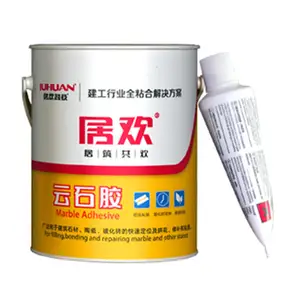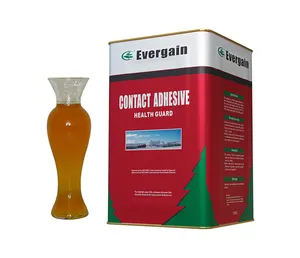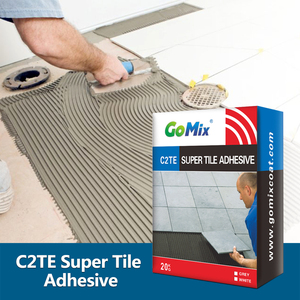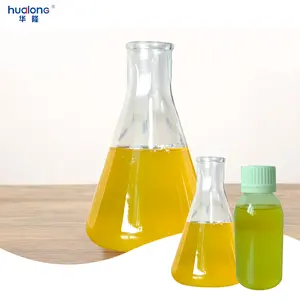Top categories

Energy Chemicals

Flavor & Fragrance

Chemical Reagents

Non-Explosive Demolition Agents

Other Chemicals

Custom Chemical Services

Biological Chemical Products

Painting & Coating

Surface Treatment Chemicals

Catalysts & Chemical Auxiliary Agents

Admixture & Additives

Pigments & Dyestuff

Basic Organic Chemicals

Agrochemicals

Inorganic Chemicals

Coating & Paint
About products and suppliers
Introduction
Embarking on a DIY project is an exhilarating journey, with the success often hinging on the materials you employ. Cement glue, also known as contact cement or concrete adhesive, is one such material that can revolutionize your DIY projects. This versatile adhesive forms a fast, flexible, and enduring bond, making it ideal for a myriad of applications. This comprehensive guide will delve into the nuances of cement glue, exploring its properties, benefits, and how to choose the right type for your project. We'll also provide a step-by-step guide on its usage, discuss safety measures, suggest innovative project ideas, and share tips on maintaining and storing cement glue.
Understanding Cement Glue: What It Is and How It Works
Cement glue, also referred to as contact cement, is a neoprene rubber adhesive that forms a swift, flexible, and permanent bond. It's particularly effective for nonporous materials that other adhesives struggle to bond. It works best on plastics, veneers, rubber, glass, metal, and leather. Unlike other glues that need to dry after assembly, contact cement is already dry on contact. Once the solvent evaporates, it forms a flexible bond with no residual moisture, eliminating the need for clamping.
Benefits of Using Cement Glue in DIY Projects
Cement glue, also known as concrete adhesive, offers several benefits for DIY projects. It's specially formulated to adhere to concrete, block, stone, and other masonry materials, providing a more durable bond than a mortar patch. It can also be used as a concrete to metal adhesive and carpet to concrete adhesive, making it versatile for various applications. Additionally, it's easy to apply, whether you're working on small home fixes or larger, more advanced jobs. The choice between polyurethane-based or epoxy-based glue depends on the specific needs of your project.
Types of Cement Glue: Choosing the Right One for Your Project
Cement glue, also known as cement adhesive, comes in various types, each with unique properties and uses. Natural cement adhesive, the most basic type, is a mix of cement, sand, and water, ideal for basic construction work. Co-adhesive, a synthetic type, is used with another adhesive or epoxy for a stronger bond. Epoxy Cement Adhesive (ECA) and Polymer Cement Adhesive (PCA) are both two-part systems, great for underwater applications and high-strength projects, respectively. ABS cement adhesive, made from a synthetic polymer, is excellent for water-involved projects. Lastly, Cyano Acrylate Co-Adhesive (CAC) is best for wet, outdoor construction projects.
How to Use Cement Glue: A Step-by-Step Guide
Cement glue, including rubber and contact cement, is a versatile adhesive used in various DIY projects. To use rubber cement, apply it to the back of the item and let it cure before attaching it to your surface. For a permanent bond, apply cement to both surfaces. Contact cement, on the other hand, forms very permanent bonds and should be used with care. It never fully cures, leaving a tacky layer ready to bond instantly when mated with another surface. Always remember to work in well-ventilated areas when using these adhesives.
Safety Measures When Using Cement Glue
When using cement glue, it's crucial to understand potential health hazards and safety measures. Cement can cause ill health by skin contact, eye contact, or inhalation. Risk of injury depends on duration and level of exposure and individual sensitivity. Wet cement contacting the skin can cause irritation or burns. Cement dust can also irritate the skin and form a caustic solution when mixed with moisture. Moreover, exposure to airborne dust may cause immediate or delayed irritation of the eyes. Therefore, it's essential to wear protective clothing and follow safe working procedures when handling cement glue.
Innovative DIY Project Ideas with Cement Glue
Cement glue can revolutionize your DIY projects, offering a strong bond for concrete creations. For instance, you can use it in making painted concrete letters, custom concrete planters, or concrete coasters. It's also ideal for larger projects like concrete countertops or desk tops. For a festive touch, consider creating concrete Christmas tree statuary or concrete pumpkins. Cement glue can also be used in crafting concrete noteholders, towel planters, or even concrete egg cups. Remember, the key to a successful project is choosing the right type of cement glue and following safety measures.
Maintaining and Storing Cement Glue: Tips and Tricks
Proper storage of cement glue is crucial for maintaining its quality and effectiveness. Keep the containers in a cool, dry, well-ventilated area, with temperatures ideally between 50°F and 120°F. Ensure all lids are secured tightly to prevent evaporation and moisture intrusion. If you're using a partial container, cap the headspace with inert gas or dry air to prevent water contamination. Always adhere to a first-in-first-out consumption schedule to ensure the oldest material is used first. Avoid using expired products, as indicated by the manufacturing and expiration dates on container labels.
Conclusion
Cement glue is a game-changer in the world of DIY projects. Its versatility, strength, and ease of use make it a go-to adhesive for various materials, from plastics and veneers to concrete and metal. Choosing the right type of cement glue for your project, following the correct application steps, and adhering to safety measures are crucial for successful outcomes. With innovative project ideas, you can create unique and durable items, whether it's concrete letters, planters, or countertops. Remember, proper storage and maintenance of cement glue ensure its effectiveness and longevity. So, whether you're a seasoned DIY enthusiast or a beginner, cement glue can undoubtedly elevate your projects to new heights.

















 浙公网安备 33010002000092号
浙公网安备 33010002000092号 浙B2-20120091-4
浙B2-20120091-4